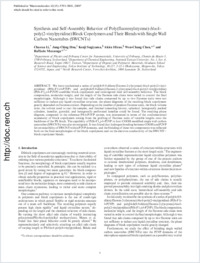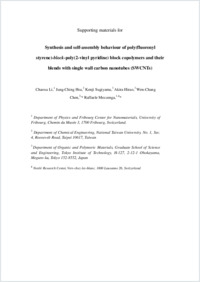Synthesis and self-assembly behavior of poly(fluorenylstyrene)-block-poly(2-vinylpyridine) block copolymers and their blends with single wall carbon nanotubes (SWCNTs)
- Li, Chaoxu Department of Physics and Fribourg Center for Nanomaterials, University of Fribourg, Switzerland
- Hsu, Jung-Ching Department of Chemical Engineering, National Taiwan University, Taipei, Taiwan
- Sugiyama, Kenji Department of Organic and Polymeric Materials, Graduate School of Science and Engineering, Tokyo Institute of Technology, Japan
- Hirao, Akira Department of Organic and Polymeric Materials, Graduate School of Science and Engineering, Tokyo Institute of Technology, Japan
- Chen, Wen-Chang Department of Chemical Engineering, National Taiwan University, Taipei, Taiwan
- Mezzenga, Raffaele Nestlé Research Center, Lausanne, Switzerland - Department of Physics and Fribourg Center for Nanomaterials, University of Fribourg, Switzerland
-
24.06.2009
Published in:
- Macromolecules. - 2009, vol. 42, no. 15, p. 5793–5801
English
We have synthesized a series of poly[4-(9,9-dihexylfluoren-2-yl)styrene]-block-poly(2-vinylpyridine) (P(St-F1)-b-P2VP) and poly[4-di(9,9-dihexylfluoren-2-yl)styrene]-block-poly(2-vinylpyridine) (P(St-F1₂)-b-P2VP) comblike block copolymers and investigated their self-assembly behavior. The block composition, molecular weight, and the length of the fluorene side chain were varied to control the final morphologies. Although it was found that side chains composed by up to two fluorene units were not sufficient to induce any liquid crystalline structure, the phase diagrams of the resulting block copolymers greatly depended on fluorene content. Depending on the number of pendant fluorene units, the block volume ratio, the solvent used to cast the samples, and thermal annealing history, spherical, hexagonally packed cylinders, lamellar, gyroidal, and hexagonally perforated lamellae could be found. The resulting phase diagram, compared to the reference PS-b-P2VP system, was interpreted in terms of the conformational asymmetry of block copolymers arising from the grafting of fluorene units of variable lengths onto the backbone of the PS block. The capability of P(St-F1n)-b-P2VP to host COOH-modified single wall carbon nanotubes (SWCNTs) was also investigated. It was found that hydrogen bonding between COOH and P2VP favors miscibility of SWCNT within P2VP domains, and the blending of these two components was reflected both on the final morphologies of the block copolymers and on the electron conductivity of the SWCNT−block copolymer blends.
- Faculty
- Faculté des sciences et de médecine
- Department
- Département de Physique
- Language
-
- English
- Classification
- Physics
- License
- License undefined
- Identifiers
-
- RERO DOC 13232
- DOI 10.1021/ma900861s
- Persistent URL
- https://folia.unifr.ch/unifr/documents/301328
Other files
Statistics
Document views: 63
File downloads:
- mezzenga_ssa.pdf: 189
- mezzenga_ssa_sm.pdf: 122

